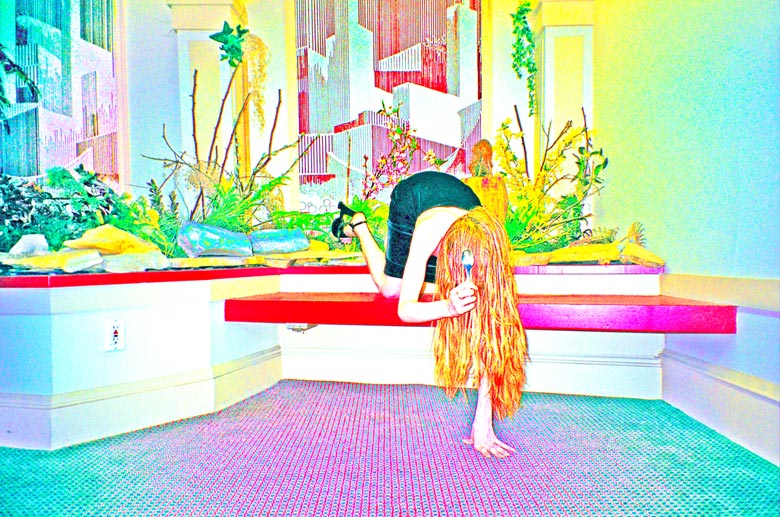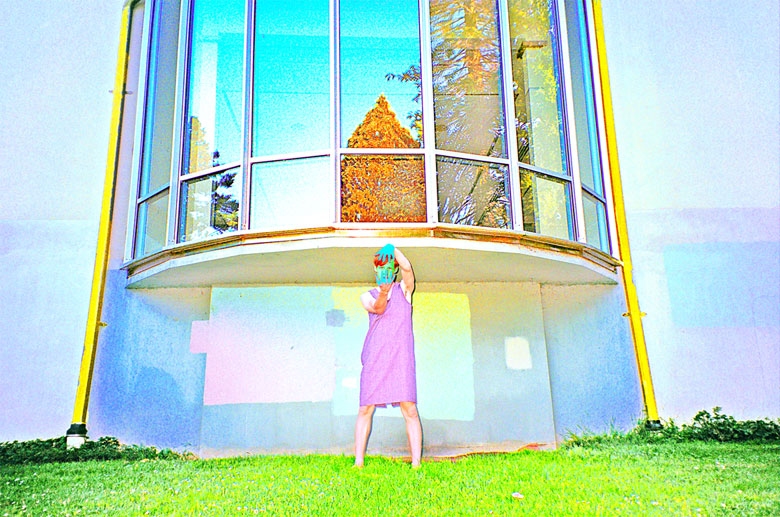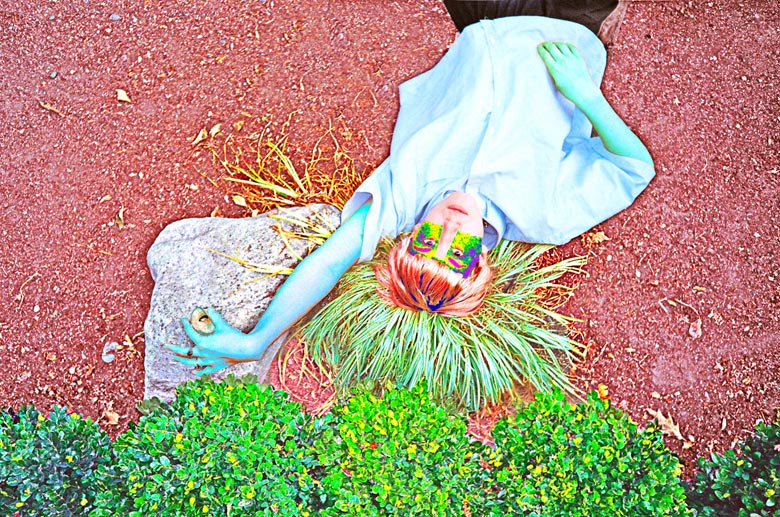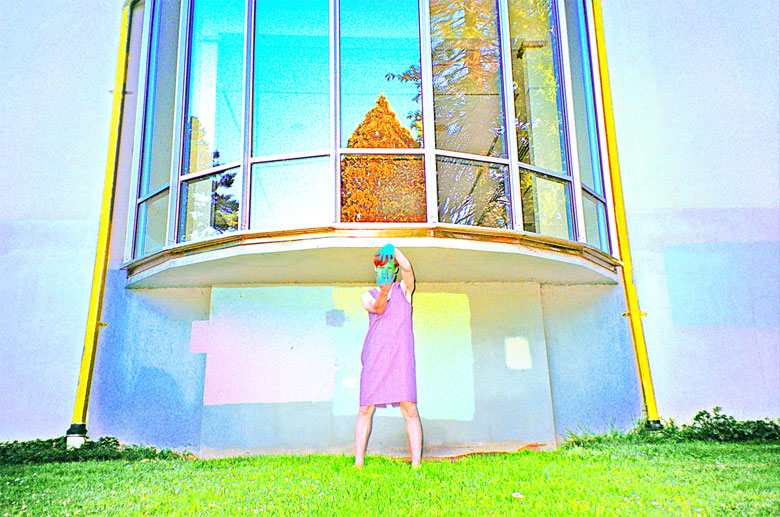
With my only hints into his personality being our overly-friendly internet communications and his off-the-wall photographic work, my mind reeled through possible iterations of what Correa might be like. By most accounts, I gathered that he would be fairly friendly – but I must shamefully confess that I was torn on whether or not Correa would be genuine in his artistic pursuit – and considering his extremely definitive style, my sometimes docile self also wondered if he might be bigger-than-life and over-the-top, or pretentious and intimidating.
As I wait outside of Correa’s apartment in Capitol Hill, which he shares with a member of Seattle electro-noise band Crypts, the feeling of nervousness persists. Correa arrives minutes after I do and greets me through the thin cloth of a purple shirt, its attached facemask pulled up past his nose. Mysterious. Inside, though, Correa quickly makes it obvious that he is hiding nothing; he raises the blinds immediately, to shine light upon the impressively sparse and tidy living room, which also serves as a creative workspace. Lining its walls is an analog modular synthesizer rig for his roommate, and for Correa, a desktop and giant TV screen doubling as a computer monitor.
He immediately proves himself a thoughtful host. He offers me Perrier on the rocks almost as soon as I sit down… and as I easily and comfortably settle in, I note to myself that I am a douche. Previous checklist of reservations? Completely off-base and unwarranted. Correa’s animated, yes – and talkative, extremely – but intimidating or over-the-top? No. Genuine? Without a doubt.
Siendo mis únicas pistas de su personalidad nuestras conversaciones súper amigables por internet y su extraordinario trabajo fotográfico, mi mente imaginaba las posibilidades de como podría ser Correa. Por lo que había escuchado, parecía que seria lo suficientemente amistoso – pero debo confesar de que no estaba segura si Correa seria genuino en su propuesta artística – y considerando su estilo extremadamente absoluto, mi lado dócil se preguntaba si él podría ser un tipo de personalidad exagerada y desmesurada, o pretencioso e intimidante.
Mientras espero afuera del apartamento de Correa en Capitol Hill, el cual comparte con un miembro de Crypts, un conjunto de electro-noise de Seattle, mis nervios persisten. Correa llega minutos después de mi y me saluda a través de la delgada tela de su camisa morada, la cual incluye una máscara que le cubre la cara hasta la nariz. Misterioso. Pero adentro, Correa hace obvio que no esta escondiendo nada; abre las cortinas inmediatamente para iluminar una sala impresionantemente vacía y limpia, la cual se presta también como espacio y taller creativo. Decorando las paredes se encuentra una instalación para el sintetizador modular analógico de su compañero de apartamento, y para Correa, un escritorio y una pantalla de televisión gigante que también funciona como monitor de computadora.
Inmediatamente me demuestra que es un anfitrión atento. Me ofrece Perrier en las rocas casi inmediatamente después de sentarme… y mientras me voy acopiando de manera fácil y cómoda, hago una nota mental a mi misma de que he sido muy mala onda. Mi previa lista de dudas? Completamente fuera de lugar e injustificada. Correa es animado, si – y hablador, al extremo – pero intimidante y exagerado? No. Genuino? Sin duda.

“Simplemente llego y me guio por lo que siento – que es lo que se ve bien, la química, de esta manera todo es simplemente así como orgánico, espontáneo, de ese momento.” — Frank Correa
“I just kind of go and feel it out – what looks good, the chemistry, so that everything’s just kind of organic, spontaneous, in the moment,” he explains.
The brunt of the work, then, lies in the aftermath of the initial shot.
“What takes the most time is editing, post-editing. That’s when I’m like, alright, it’s a whole new thing. It has nothing to do with photo shoot day, because what happens there then is just the backbone to what will happen,” he says. “With the rest, I fill up and add on and paint it and make it the way I want it. A lot of times, I never know what it’s going to look like until I get my film back, and then I work on it.”
Nos explica, “Simplemente llego y me guio por lo que siento – que es lo que se ve bien, la química, de esta manera todo es simplemente así como orgánico, espontáneo, de ese momento.”
Es así que la mayoría de la obra, se basa sobre el resultado de la toma inicial.
“Lo que toma mas tiempo es la edición. Es ahí cuando me doy cuenta de que es toda una obra nueva. No tiene nada que ver con el día de la sesión de fotos porque lo que pasó ahí es simplemente el esqueleto de lo que va a ser,” nos dice. “Con el resto, lleno, agrego, lo pinto y lo convierto en lo que quiero. Muchas veces, nunca sé como se va a ver hasta que me regresan el último negativo y me pongo a trabajar en él.”
FRANK CORREA PHOTOGRAPHER INTERVIEW CONTINUES BELOW




“I actually started with digital – but I didn’t like the idea of taking all of these photos and breaking your head with which one you like better. And I didn’t like the look of it [back then]… One time, the camera kind of started fucking up, and luckily, I had a disposable camera,” recalls Correa.
Those circumstances led him to the discovery that he liked the look of film better than digital; and with affordable film processing at Walgreen’s, disposable cameras proved themselves to be a cheap and efficient tools.
“I could just get three and snap around, whatever… I liked the process and how easy it was,” he shares.
Correa opens up Photoshop to give me a sneak peak into the barebones components of his process – something he assures me he almost never shows to anyone. I am instantly amazed by the extent to which the original differs from the final product. The initial photo is hardly fancy or flattering at all; it is merely the canvas for more robust work of the imagination. Correa’s photos are also digital collages manipulated to the nth degree, into which he mixes an array of supplementary images. He shoots photos on his iPhone, pulls stock photography off the internet, and scans images from books and magazines – whatever is necessary to create his off-kilter worlds of fantasy.
But what is most immediately gripping about Correa’s work, and most vital to his embrace of the digital medium, is his bold use of colors. Bright neons manipulate and deform pixels, sharpen edges in uncanny ways, and add fascinating degrees of hardness into a world of soft humans. Nonetheless, it is ultimately the humans – adventurous ones who are willing to serve in Correa’s world – that really makes the pieces pop.
“I guess I’m lucky, because I have friends that are just down… people, friends, who are willing to do anything,” explains Correa.
“En realidad empecé digital – pero no me gustaba la idea de tomar todas estas fotografías y después romperte la cabeza para ver cual te gusta más. Y no me gustaba como se veía [en ese entonces]… Un día, la cámara empezó a no querer trabajar, y por suerte, yo traía una cámara desechable,” se acuerda Correa.
Fueron esas circunstancias las que lo llevaron a descubrir que le gustaba más como se veía el rollo fotográfico que lo digital, y con revelado de negativos a precios razonables en Walgreen’s, las cámaras desechables probaron ser una herramienta baratas y efectivas.
“Yo podía llegar y simplemente tomar fotos, lo que fuera… me gustó el proceso y lo fácil que es.”
Correa abre Photoshop para darme un anticipo de los elementos básicos de su proceso – algo que me asegura casi nunca le muestra a nadie. Inmediatamente, me encuentro asombrada por lo mucho que la copia original es diferente al producto final. La foto inicial es corta de ser sofisticada o halagadora; es simplemente el lienzo para una obra mas robusta de la imaginación. Las fotografías de Correa son también un collage digital manipulado al máximo, dentro de las cuales combina una variedad de imágenes suplementales. Él toma fotos en su iPhone, saca fotos ya existentes del internet, y escanea imagines de libros y revistas – lo que sea necesario para crear sus mundos de fantasía fuera de lo común.
Pero lo que inmediatamente llama la atención sobre el trabajo de correa, y lo mas vital sobre su acogida al medio digital, es su atrevido uso de colores. Neones brillantes manipulan y deforman pixeles, incrementan los bordes de las imágenes de manera sorprendente, y agregan altos niveles de aspereza en un mundo de humanos suaves. Sin embargo, a final de cuentas son los humanos – aventureros que están dispuestos a servir en el mundo de Correa – quienes realmente hacen que la imagen se destaque.
“Supongo que tengo suerte porque tengo amigos que se prestan a este tipo de trabajo… gente, amigos que están dispuestos a hacer lo que sea,” explica Correa.
FRANK CORREA PHOTOGRAPHER INTERVIEW CONTINUES BELOW


“Quiero mas emoción. Quiero que sea mas cinematográfico, si se puede. Quiero mas sentimiento.” – Frank Correa
“[The poses] just kind of come to me, but I always tell myself as I get my photos back at this point that I feel like I want to start telling people to give me more drama and not just stand there in a pose. I want more emotion,” he explains. “I want to make it more cinematographic, if that even applies on this. Just more feeling.”
Correa’s photography is getting more and more attention, and he is becoming known for his definitive style – but he wants to push himself to do different things. He fantasizes about doing underwater shots, or even traversing the world of skydiving if it would yield a worthwhile photographic result. In the meantime, he is working on a new series of work that will come with a whole new style.
“I am in a weird stage [right now] because people know me for what they’ve seen, but there’s actually so much that hasn’t been out yet that I’m actually working on and am excited about,” Correa explains. He parallels the slow process of showing his work to that of recording music. “You record a rock song, and it doesn’t come out until a year later after it’s gone through all this shit, and it’s kind of annoying, because I’m already over this, but it hasn’t seen the light of day yet.”
To the outside and casual observer, it may be difficult to tell what has changed in Correa’s new series of works, for they still adhere to many of the same basic color palettes and conceptual principles as before. It is only when the new and the old are compared side-by-side that one begins to see the increased focus on composition and more challenging use of angles and forms in the new batch. But what is even more important than visual clues is Correa’s evolution in understanding and accepting his own vision. As he sounds off about his recent revelations and philosophical changes, I come back to square one of our meeting, for his defenses are down, and it is striking how earnest and particular he is about his goals.
“Now, I know what [my photos] are rather than, ‘I don’t know what I’m doing; I’m just doing what looks good.’ I know what I want,” Correa says, of his past year of growth. “I’ve always been producing, exercising, and I feel like I went through my exercise phase – but [now]… I feel like people recognize it more and I spend more time, more care, more love. They’re like my babies. Before it was all fun and games, whatever, photo shoots. But now I’m serious, in the best way.”
“[La pose] simplemente me llega, pero siempre me digo a mi mismo que a este punto siento que quiero empezar a pedirle a los modelos que me dan mas drama y que no solo estén ahí parados. Quiero mas emoción,” él nos explica. “Quiero que sea mas cinematográfico, si se puede. Quiero mas sentimiento.”
Las fotografías de Correa están empezando a recibir mas y mas atención, y esta llegando a ser conocido por su estilo absoluto – pero quiere esforzarse a hacer cosas diferentes. Tiene fantasías de hacer tomas bajo el agua, o incluso cruzar dentro del mundo de paracaidismo si esto significaría producir un resultado fotográfico que valga la pena. Mientras tanto, él está trabajando en una nueva serie de obras que tendrán un estilo completamente nuevo.
“Me encuentro en un periodo raro [en estos momentos] porque la gente me conoce por lo que han visto, pero en realidad hay todavía tanto que no ha salido aún, en el que estoy trabajando y por el cual estoy emocionado,” Correa explica. Hace paralelos entre el lento proceso de mostrar su trabajo a el de grabar música. “Cuando grabas una canción de rock, y no sale al público sino hasta después de un año y habiendo pasado por mucho, es un poco molesto porque ya has perdido interés y tu trabajo ni si quiera ha visto la luz del día aún.”
Al observador casual y ajeno, se le podría hacer difícil reconocer qué es lo que ha cambiado en la nueva serie de obras de Correa, porque continúan adhiriéndose a muchas de las mismas paletas básicas de colores y principios conceptuales que anteriormente. Es solamente cuando lo nuevo y lo viejo son comparados lado a lado que uno empieza a ver el enfoque incrementado en la composición y el uso más desafiante de ángulos y formas en la nueva serie. Pero lo que es aún mas importante que las pistas visuales, es la evolución de Correa en el entendimiento y aceptación de su propia visión. Mientras continua hablando de sus recientes revelaciones y cambios filosóficos, regreso al principio de nuestra entrevista, él ha bajado la guardia y es admirable lo serio y particular que es sobre sus objetivos.
“Ahora, sé lo que son [mis fotos] en lugar de ‘no se lo que estoy haciendo, solo se que se ve bien.’ Sé que es lo que quiero,” nos dice Correa sobre el pasado año de crecimiento. “Siempre he estado produciendo, practicando, y siento que pase por mi etapa de práctica – pero [ahora]… siento que la gente lo reconoce mas y le pongo mas tiempo, mas cuidado, mas amor. Son como mis bebés. Antes, todo era diversión y juegos, sesiones de foto de lo que fuera. Pero ahora, soy mas serio, de la mejor manera posible.”
frankcorrea.tumblr.com



Ω







BOOM! Frankie we love you!